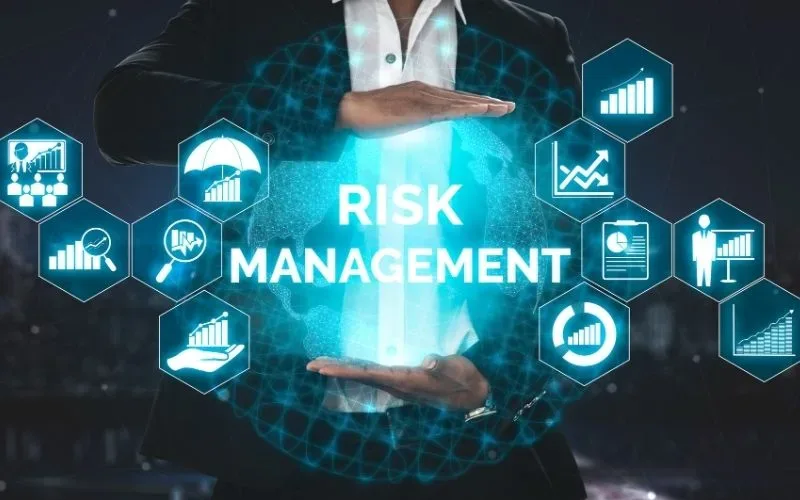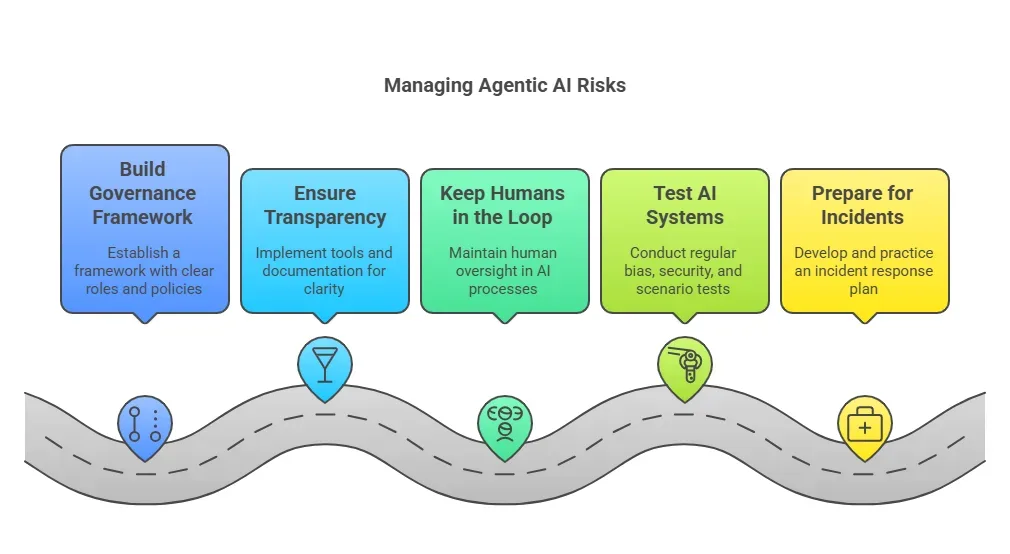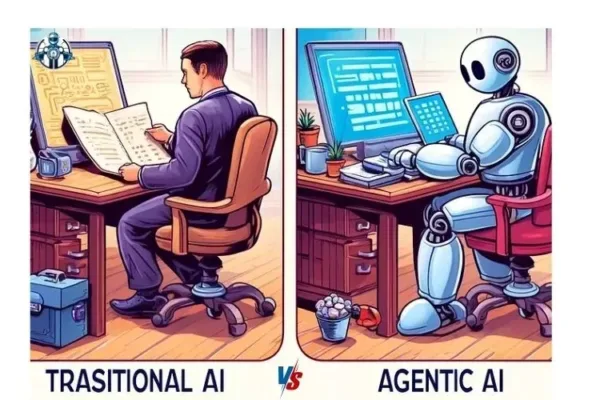Agentic AI, or AI that is capable of decision-making is revolutionizing business. Although this technology is promising, it also poses new challenges that firms need to know. Here, we’ll discuss what Agentic AI is, the threats it brings, and how companies can protect themselves from it.
Listen to our Podcast: What Should Enterprises Know About Agentic AI Risks?
Types of Agentic AI Risks

Risk 1: Security Breaches
AI systems with agentic properties are generally involved with processing private information, such as customer or organizational information. If it is hacked, then the hackers can get the information from it or manipulate the system to carry out wrong actions.
Uncover how Agentic AI is shaping the future in What is Agentic AI and How Is It Revolutionizing Technology?
How to Reduce Risk:
- Use strong encryption for data.
- Continuously try to find the AI’s flaws.
- Restrict the AI from connecting to certain systems.
Risk 2: Bias and Unfair Decisions
Agentic AI is trained by data and thus, if data is biased, then the AI will be too. This can result in social injustice to customers or even employees.
Find out how Agentic AI is transforming the finance world in How Will Agentic AI Revolutionize Financial Services?
How to Reduce Risk:
- Check training data for biases.
- Test AI decisions for fairness.
- Incorporate people of all genders in the development of artificial intelligence.
Risk 3: Operational Failures

If Agentic AI gets it wrong then this can cause problems in the business. For instance, an AI in charge of a factory may fail to estimate equipment repairs properly and this will lead to breakdowns.
Understand the role of automation in Agentic AI in What is Agentic Automation?
How to Reduce Risk:
- Ensure that there is a clear cut on what AI is permitted to decide.
- Include human intervention when it comes to important work.
- Make sure to plan for contingencies in case of failure of the Artificial Intelligence.
Risk 4: Legal Problems
AI has not been regulated by law to this date. If an Agentic AI chosen by the company violates privacy rights or is prejudiced against people, the company may be penalized or sued.
How to Reduce Risk:
- Stay updated on AI laws in your region.
- Work with legal experts to review AI systems.
- Document all AI decisions for accountability.
Learn how Agentic AI powers autonomous systems in our blog, How Can Agentic AI Help Build Autonomous Systems from Scratch?
Risk 5: Reputation Damage
Another disadvantage of an Agentic AI is that if it acts in public, for instance, to pass wrong information or annoy customers, it may embarrass a firm.
How to Reduce Risk:
- Monitor AI interactions with customers.
- It is possible to prevent AI from discussing certain topics.
- Outline a crisis response plan for AI errors.
How to Manage Agentic AI Risks

Self-driving AI can be useful, but companies should approach it cautiously to avoid issues. The following are the measures that companies should consider to minimize risks while applying this technology.
Looking for investment opportunities? Check out Top 5 Agentic AI Stocks to Watch in January 2025 for insights.
Step 1: Build a Strong Governance Framework
A governance framework is the definition of the principles and practices that are to be followed in the organization with regard to AI. This makes it possible to make sure that AI systems are safe, they are not biased and they do not break the law.
What to Include in a Governance Framework:
- Clear Roles: Identify individuals or groups to manage AI initiatives. For instance, the role of “Risk Manager” can look for any possible prejudice in decisions made by AI.
- Policies for AI Use: Explain the limitations and the possibilities of AI. For instance, “It is only possible for the AI to approve loans whose value does not exceed $100,000.”
- Regular Audits: It is advised to perform a check on AI systems every 3-6 months to find out if there are any mistakes or prejudices.
Discover how SOC teams are leveraging Agentic AI for enhanced security in How Is Agentic AI Transforming SOC Teams in 2025?
Step 2: Ensure Transparency in AI Decisions

Explanation means that one is able to see how an AI reason. The problem with a black box (if that is what the AI system is in this case) is that it is hard to trust or even repair.
How to Improve Transparency:
- Use Explainable AI Tools: These tools help to present the decision-making process of an AI in a very simple way. For instance, a loan approval model can reveal which attributes – such as income or credit score – led to the decision.
- Document Everything: Documentation of the training process of AI, the type of data that it uses, and the decision-making process.
Explore the foundational design of Agentic AI in our blog, What Is the Baseline Architecture of Agentic AI Systems?
Step 3: Keep Humans in the Loop
Even the smartest AI can make mistakes. Humans should monitor AI decisions, especially for critical tasks like healthcare diagnoses or financial approvals.
Examples of Human Oversight:
- Approval Steps: An AI can suggest actions, but a human must approve them.
- Emergency Stop Buttons: Allow humans to pause AI systems instantly if they act strangely.
Step 4: Test AI Systems Regularly
Testing helps catch problems before they cause harm. Think of it like a car inspection—regular checks keep things running safely.
Want to know how Agentic AI stacks up against Traditional AI? Read our detailed comparison in Agentic AI vs. Traditional AI: Key Differences and Why It Matters
Types of Tests for Agentic AI:
- Bias Testing: Check if the AI treats all groups fairly.
- Security Testing: Hire ethical hackers to try breaking into the AI system.
- Scenario Testing: Simulate emergencies (e.g., data breaches) to see how the AI reacts.
Step 5: Prepare for Incidents
Even with careful planning, problems can happen. A response plan ensures teams know how to react quickly.
Curious about how LLMs differ from Agentic AI? Learn more in What is the Difference Between LLM and Agentic AI?
Incident Response Plan Checklist:
- Identify Risks: List possible AI failures (e.g., data leaks, biased decisions).
- Assign Teams: Designate who will fix technical issues, talk to customers, or handle legal problems.
- Practice Drills: Run mock emergencies to test the plan.
FAQs About Agentic AI Risks
What are the challenges of Agentic AI?
Agentic AI faces challenges like security breaches, biased decisions from flawed data, and unexpected operational errors. Ensuring human oversight and compliance with laws adds complexity.
What are the limitations of agentic AI?
Agentic AI can’t handle situations outside its training data and may act unpredictably. It relies heavily on data quality and requires constant monitoring to avoid mistakes.
What is the risk of AI in business?
Risks include data leaks, unfair customer treatment due to bias, legal fines, and system failures disrupting workflows. Poorly managed AI can also harm a company’s reputation.
What are some risks related to AI that should be disclosed?
Disclose risks like privacy violations, hidden biases in decisions, security flaws, and legal non-compliance. Transparency about AI’s limits and errors is critical for trust.
Final Words
Agentic AI offers huge benefits but requires careful handling. By understanding risks like security breaches, bias, and legal issues, businesses can use AI safely. Plus, steps like strong governance, human oversight, and regular testing are key to avoiding problems. As AI grows smarter, companies that plan ahead will stay ahead—and keep their customers, employees, and data safe.












4 thoughts on “Agentic AI vs. Traditional AI: Key Differences and Why It Matters”